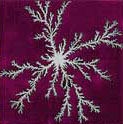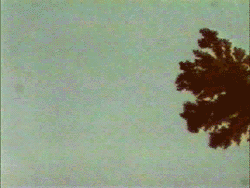Growing a Metal Crystalline Deposit
So that we can explain this experiment to you, we begin with a very short review of kitchen table chemistry:
 To grow the zinc frost in the picture (which has false background color)
a negative post attached to a battery, or power supply, was inserted
into a solution of zinc sulfate. The small negative post attracted the
positive zinc ions in the solution. When they arrived at the post,
they gained a negative charge from the battery (or power supply), and
attached to previous zinc ions already present. In this fashion an
"aggregate" of zinc ions accumulated. Because of the way that zinc
ions bond, at a microscopic level the ions form a crystal. But
because of the environment for this particular growth, a branching, wavy
structure grows. This is similar to the growth of wavy ice patterns on
a window or windshield, as opposed to the more highly ordered growth of
snowflake.
To grow the zinc frost in the picture (which has false background color)
a negative post attached to a battery, or power supply, was inserted
into a solution of zinc sulfate. The small negative post attracted the
positive zinc ions in the solution. When they arrived at the post,
they gained a negative charge from the battery (or power supply), and
attached to previous zinc ions already present. In this fashion an
"aggregate" of zinc ions accumulated. Because of the way that zinc
ions bond, at a microscopic level the ions form a crystal. But
because of the environment for this particular growth, a branching, wavy
structure grows. This is similar to the growth of wavy ice patterns on
a window or windshield, as opposed to the more highly ordered growth of
snowflake.
The experiment works like this: A solution of zinc sulfate is sandwiched between two plates of glass. At the center of the plates is an exposed negative wire. The positive zinc ions in the solution are attracted to this wire, and attach to it. Subsequently, more zinc ions attach themselves to the deposit which is kept negative. With time the branched aggregate develops. The pattern which develops can be controlled by changing the applied voltage. This is what sets the negative charge on the central wire. A careful inspection of the zinc branches shows that they are dendrites similar to the the branches of a snowflake.
|
 To your right is a movie of
copper suflate electrodeposition viewed through a microscope.
To your right is a movie of
copper suflate electrodeposition viewed through a microscope.